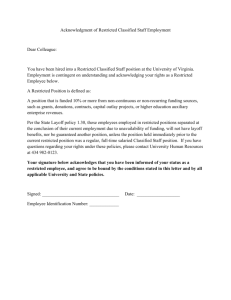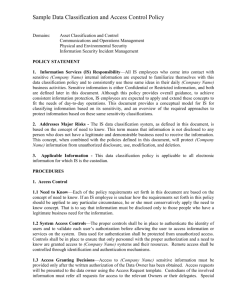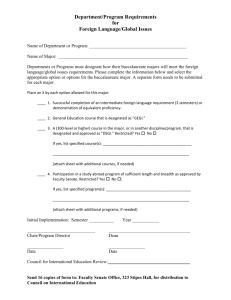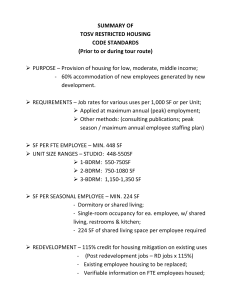Flightline Security Standards - The Whole Building Design Guide
advertisement
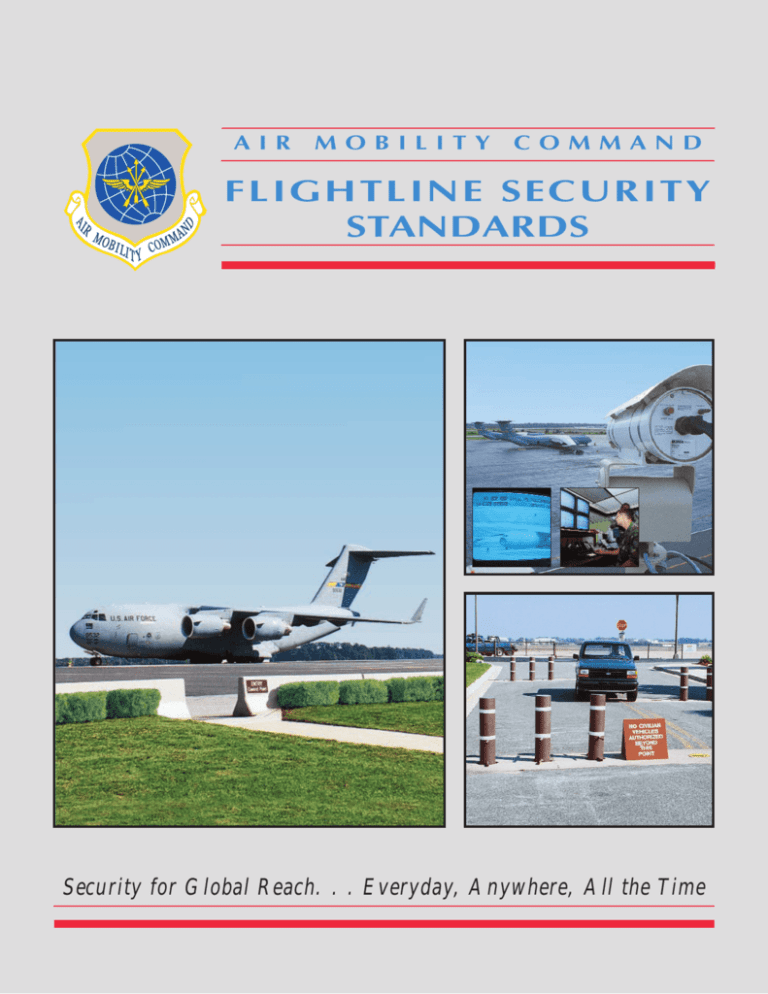
A I R M O B I L I T Y C O M M A N D FLIGHTLINE SECURITY STANDARDS Security for Global Reach. . . Everyday, Anywhere, All the Time Airfield operations are the backbone of the United States Air Force mission. Operations, maintenance, security, and other key support functions form the nucleus to provide a safe, secure environment for critical national defense assets. An effective flightline security program provides the cornerstone for “Responsive Global Reach for America...Every Day!” Without it, global reach is not attainable. Commanders should use this standard to ensure they make the right nearterm and long-term decisions and commitment of resources for protecting our people and resources. i Table of Contents Chapter 1 Introduction 1 A. General B. Purpose C. Project Development 1. Planning 2. Programming 3. Design 4. Construction D. Ownership E. Risk Analysis F. THREATCONs Chapter 2 Training A. B. C. D. 5 General Base Introduction Briefings Unit Training Public Affairs Chapter 3 Design Standards A. B. C. D. E. F. G. H. I. J. General Aircraft Parking/Restricted Areas Barriers Lighting Closed-Circuit Television Entry and Circulation Controls Intrusion Detection Systems Restricted Area Clear Zones Industrial Maintenance Complexes Base Roads References List of Figures Number Figure 1-A Figure 1-B Figure 3-A ii 7 Description Security In-Depth Highlights of the Planning, Programming, Design, and Construction Process Flightline Security Concept Plan 18 Page 1 3 16 Chapter 1 Introduction A. General The Air Mobility Command (AMC) flightline security program combines the efforts of the security police and base military and civilian personnel with state-of-the-art electronic, and physical security barriers. Program enforcement begins with entry control requirements at each base gate. The military and civilian personnel who work and live on the base provide the next level of protection by reporting suspicious activities or entrance of unauthorized personnel. This is an integral part of the security program since it relies on everyone’s involvement and sense of responsibility for flightline security. Security police patrols add another layer of protection by monitoring activity onbase, looking for any unusual activity, and responding to calls for police assistance. The flightline physical barriers, electronic systems, and identified boundaries clearly delineate restricted areas. Additional security patrols detect, respond to, and neutralize incidents involving restricted aircraft parking aprons. Owner/user personnel execute the final layer of protection in the security in-depth approach. All aircrew, maintenance, and other essential personnel with daily duties inside restricted areas are responsible for surveying their work areas to detect and report unauthorized personnel or actions. This multilayered team approach makes undetected penetration of flightlines much harder for the potential adversary, terrorist, criminal, or political activist. AMC aircraft parked on other U.S. bases, allied installations, or foreign international airports, may not be afforded a level of security that meets the standards of the governing instructions. Aircraft commanders must confirm that off-station aircraft (CONUS or overseas) security is equivalent to the requirements of this standard, the applicable MCI 11 series instruction, and AMC Sup 1 to AFI 31-101, Air Force Physical Security Program. Equivalence is determined by assessing the threat, security presence, detection capabilities, entry control measures, and response capabilities at the location, then comparing them to this standard. BASE GATES ND CIVILIAN PERSONNEL MILITARY A LAW ENFORCEMENT PATROLS FLIGHTLINE BOUNDARIES SECURITY PATROLS OWNER/USER Figure 1-A: Security In-Depth. 1 INTRODUCTION The flightline security program addresses the requirements for aircraft protection in accordance with AFI 31-101. B. Purpose This standard provides the basic criteria necessary to organize, evaluate, plan, program, and design flightline security features on AMC bases. This information is intended to make commanders and their staffs aware of the importance of personnel training and to aid in security considerations and project development. This document is for use by commanders, security police, Headquarters AMC staff, design architects, engineers, and others involved in developing flightline security features. It is intended to help all participants recognize effective flightline security requirements and design criteria so they can actively participate in the project development process. Use this guide to supplement other Air Force and Department of Defense (DoD) policies and instructions. Chapter 2 addresses flightline security training and awareness programs. Chapter 3 discusses the design standards for flightline security features. C. Project Development This standard is applicable to all AMC flightline security projects, including new construction, as well as maintenance and repair projects. It provides standards and criteria for determining requirements and evaluating current programs and overall designs. Additional information is available at each base regarding unique program and design requirements. The key elements to a successful project delivery are planning, programming, design, and construction. 2 1. Planning Good planning establishes the foundation to determine project requirements and provides the means to meet the objectives of the flightline security program. Planning must be long-term and should include a detailed timetable for project completion. 2. Programming Programming includes determining user requirements, developing solutions, identifying funding sources, and forwarding programming documents to the appropriate review and approval authorities. Each programmed project should be consistent with the base comprehensive plan and architectural compatibility guide for new and existing facilities. Work is classified as military construction, maintenance, repair, or minor construction. Information required during preparation of the DD Form 1391, which initiates project development, is found throughout this standard. Included are considerations for security systems, lighting, physical barriers, and special factors for use in estimating costs. 3. Design Design includes concept development, design reviews, and final design drawings and specifications. It is important for civil engineering and flightline team personnel (operations, security police, safety, and logistics) to actively communicate throughout the design process to execute a successful project. Integration of engineering and architectural design considerations during the development of flightline security projects ensures a well-coordinated base appearance. Before planning projects, analyze the existing site conditions, infrastructure, and overall security requirements. The designer should include infrastructure improvements concurrently with projects when appropriate. INTRODUCTION 4. Construction Quality reviews of the contractors’ submittals by project engineers and frequent on-site inspections by civil engineer construction management personnel and the user will help ensure design goals are met. PLANNING ◆ ◆ ◆ ◆ ESTABLISH OBJECTIVES DETERMINE REQUIREMENTS COMPLETION SCHEDULE SITE SELECTION PROGRAMMING ◆ PROJECT SCOPE ◆ IDENTIFY FUNDING SOURCES(1) ◆ DD FORM 1391(1) ◆ DEVELOP RAMP(1)(2) - FUNCTIONAL REQUIREMENTS - DESIGN CRITERIA - COST INFORMATION DESIGN ◆ FACILITY DESIGN - VALIDATE USER REQUIREMENTS ◆ ◆ ◆ ◆ ◆ CONSTRUCTION BASE APPEARANCE ARCHITECTURAL DESIGN DETAILED COST ESTIMATE CONTRACT PACKAGE ADVERTISE ◆ AWARD CONTRACT ◆ SURVEILLANCE/ INSPECTION - CE - USER ◆ AS-BUILT ◆ SATISFY USER NEEDS Figure 1-B: Highlights of the Planning, Programming, Design, and Construction Process. Legend for Figure 1-B: (1) AFI 32-1032, “Planning and Programming Real Property Maintenance Projects using Appropriated Funds,” identifies funding sources and criteria for selection. (2) Requirements and Management Plan. 3 INTRODUCTION D. Ownership F.THREATCONs The key to a successful flightline security program is the active involvement of the Installation Security Council (ISC) and the Resource Protection Executive Committee (RPEC). These groups oversee the establishment of policies to maintain coordination, functionality, and integration of flightline and base security programs. Ownership implies the inherent responsibility to maintain an effective program within the context of the base’s exterior design standards. When undertaking projects, all involved agencies need to actively participate throughout the project to ensure security requirements are met. This standard discusses routine security features and measures around the flightline. Threat conditions (THREATCONs) require a higher level of security features and measures. Security planners should consider how to augment daily measures and determine what additional flightline security features, if any, are necessary to imple■ ment higher THREATCON procedures. E. Risk Analysis The ISC and RPEC should tailor their security program to meet the primary threat of an overt attack or criminal act against flightline resources. Base vulnerability surveys are the best way to identify these threats and assess the current security climate. The local base Air Force Office of Special Investigation (AFOSI) can conduct surveys (human vulnerability assessments and critical target areas) to identify specific threats and vulnerabilities. The results of these surveys assist the base in determining an appropriate direction to implement the physical flightline security measures. The wing commander may direct additional security measures upon assessment of the primary threat. 4 Chapter 2 Training A. General Training is an important element in educating personnel on a base’s flightline security program. It is particularly important to take a multilayered approach, requiring all base military and civilian personnel to be aware of their responsibilities for flightline security. This approach includes awareness training to ensure personnel do not drive in restricted areas and know how to report suspicious behavior or unauthorized personnel anywhere on the base. Unit commanders should pursue several courses of action to achieve the proper level of training and awareness. The following measures can ensure all personnel receive adequate training. B. Base Introduction Briefings The “Intro Briefing” provides an excellent opportunity to explain the scope and importance of the flightline security program. It ensures that all new base arrivals, regardless of their functional area, receive the briefing on this program. As the wing commander’s representative for monitoring the status of the flightline security program and as the resident expert on security matters, the Flightline Constable can present this briefing in a variety of formats: verbal, sound on slide production, or video format. Whichever method is chosen, the briefing should cover the following: location of the flightline area, entry procedures, physical layout, and repercussions for illegally The base introduction briefing by the Flightline Constable is one of the most effective means to educating personnel about flightline security. 5 TRAINING entering restricted areas. Additionally, a summary of the base’s annual report of security incidents or intrusions may be helpful in highlighting the importance of the program. D. Public Affairs While wings have more control administering training to military and civilian personnel, base populace education and motivation present a challenge. One of the most convenient means to educate and motivate the base populace is through security-related articles published in the base newspaper. A series of well-planned, educational, and motivational articles that emphasize the role everyone plays in flightline security can be an effective tool. Additionally, publicizing security exercises and recognizing individuals who have reported security incidents can be effective for program support. The security police should coordinate a publication plan with the local Public Affairs ■ office to print articles at regular intervals. C. Unit Training Each unit, through its training or security manager, must develop and maintain an annual training program to ensure all members remain knowledgeable of their flightline security responsibilities. The Flightline Constable can assist in this process either through development of training or conducting annual training for each unit. CU R I TY P O L I C T EN OF THE E AI RC D E PA FO RT R M SE A E E E R IT IC UN D 6 ST M AT E S O F A Chapter 3 Design Standards A. General Today’s AMC flightlines are home to some of the most sophisticated, expensive, and critical military airlift and air refueling aircraft in the world. The physical security standards described in this chapter, along with sound local planning, risk management, and strong security procedures, can provide the necessary security to deter, delay, and detect an overt attack or criminal act against these resources. This chapter provides specific recommendations on implementing flightline security measures for different areas of the base. The purpose is to show examples of flightline security features applicable to your facilities. Installation of these features, consistent with your base comprehensive plan and architectural compatibility guide, will help ensure they blend with the base design scheme and materials. The flightline area includes the industrial maintenance complex (to the left) and the ramps and taxiways. 7 DESIGN STANDARDS B. Aircraft Parking/ Restricted Areas Restricted aircraft parking areas are the final detection zones for flightline assets. Protect AMC aircraft, mission support aircraft ( i.e., C-9, C-21, and C-12), and AMC contracted commercial aircraft to the same standard—Priority C. Secure higher priority aircraft as outlined in AFI 31-101. Clearly delineate boundaries to identify each area. ◆ Use raised barriers to delineate restricted aircraft parking and transient parking areas. ◆ Post conspicuous “Restricted Area” signs around the entire flightline area to preclude accidental entry by unauthorized personnel, provide the security police with the legal authority to enforce security within the areas (with deadly force, if necessary), and create the legal foundation for criminal prosecution in accordance with AFI 31-101. ◆ For the design and placement of signs refer to AFP 88-40, Sign Standards, and AFI 31-101. ◆ Transient aircraft parked in a restricted area. Raised barriers clearly delineate restricted areas. Type A fencing along a Priority C boundary. 8 DESIGN STANDARDS Prominently identify flightline entry control points and boundaries. Highly visible entry control points prevent accidental entry and, with the use of restricted area badges, help identify unauthorized personnel. ◆ Limit entry control points to the minimum necessary to balance operational, emergency, and security needs. ◆ Removable serpentine barriers demarcate vehicle entry control points. Flightline access points should be easily identifiable. Use signs at entry control points to warn unauthorized personnel of restricted areas. Portable barriers used to close an entry control point. 9 DESIGN STANDARDS C. Barriers Physical barriers are effective, highly visible, and versatile security measures and, as proven at commercial airports, provide an excellent means to separate the general populace from flightline activities. Barriers serve a variety of purposes: they create a restricted area boundary, prevent access or channel personnel to entry control points, obscure restricted areas from casual observation, and provide an obstacle to easy foot/vehicle access. Use Type A (7’-0” high, 9 gauge) fencing as a raised barrier to delineate restricted area boundaries on AMC flightlines. Construct Type A fencing in accordance with the Electronic Security Equipment Siting Criteria (ESE-SIT-0001) for future installation of Intrusion Detection Equipment (IDE) as it becomes available for Priority C resources. ◆ Existing fencing that is not Type A may remain providing it is in good condition. ◆ Select ornamental barriers near highly visible public areas such as the base’s main gate. Select metal fences with protective coatings for durability and low maintenance. 10 DESIGN STANDARDS Consider selecting fences with protective coatings to reduce glare and increase longevity/durability. ◆ If Type A fencing is not feasible due to cost, safety, terrain, or other factors, use the following acceptable alternative barriers to delineate a restricted area: ● Jersey barriers, concrete blocks or pots, brick walls, concrete walls, wrought-iron fences, etc. ● Use ropes and stanchions to create temporary restricted areas for aircraft parking (i.e. Priority A/B resources inside a Priority C restricted area). ◆ ● ● Provide painted red lines, a minimum of 4” wide, only at entry control points, taxiway gaps, and where safety precludes using a raised barrier. Using serpentine or star barriers is an effective means to restrict or close flightline access roads and/or slow vehicles down. Construct these barriers so they are easily seen and portable. Bollards can prevent vehicular access while allowing pedestrians to enter restricted areas. Use barriers to screen restricted areas from public view. Provide durable barriers between public roads and restricted areas. Post warning signs along painted lines. 11 DESIGN STANDARDS ● Natural barriers such as bushes, shrubs, earthen berms, ditches, etc., can delineate restricted area boundaries without appearing to be security barriers. They can also be integrated with other forms of barriers. For example, planting shrubbery in front of a concrete barrier or inside a concrete planter improves the appearance. Ensure “Restricted Area” signs can be easily seen when adjacent to natural barriers. Consider shrub hedges as an acceptable barrier adjacent to public areas. Shrubs can enhance the appearance of public entrances to the flightline. 12 DESIGN STANDARDS D. Lighting Well-lighted restricted aircraft parking and maintenance areas are essential for safe and secure flightline operations. Lighting makes night operations safer and also helps flightline personnel and security forces detect intruders before they reach the resources and cause damage. Follow Military Handbook-1190 (Facility Planning and Design Guide) for lighting level requirements on the flightline. Provide the same lighting levels for all aircraft parking areas. ◆ Ensure the industrial maintenance complex receives the appropriate lighting level for aircraft maintenance activities. ◆ Plan and design lighting systems to complement closedcircuit television/video systems. Adjust camera locations if lighting systems interfere with picture clarity. ◆ Adequate lighting is important to flightline security and operations. 13 DESIGN STANDARDS E. Closed-Circuit Television Closed-circuit television (CCTV)/Video systems are an integral part of the flightline security program. The AMC CCTV/Video system is a multi-organization system used by the Security Police, Command Post, and Maintenance Aircraft Coordination Center. Wings are not required to fund and procure their own CCTV/Video system (it will be funded and provided for them through the AMC CCTV/Video Program Concept of Operations). They should consider it as part of their upgrade program and plan accordingly. The AMC CCTV/Video Concept of Operations contains the following: CCTV systems provide 24-hour day/night surveillance of all flightline aircraft parking and designated maintenance areas. ◆ CCTV monitoring capability at the Security Police Control Center, Command Post, and Maintenance Aircraft Coordination Center with on-demand record capability from one primary and one alternate location. ◆ Full-matrix switching to enable all users to independently monitor any camera simultaneously. ◆ Cameras with tilt, pan, zoom, and low light capabilities. ◆ Install CCTV/Video systems to monitor all flightline parking and designated maintenance areas. 14 DESIGN STANDARDS F. Entry and Circulation Controls H.Restricted Area Clear Zones Entry and circulation controls help prevent unauthorized entry, detect hostile actions, and prevent unauthorized removal of equipment. All personnel working in restricted areas complement these controls through their continuous observation of restricted areas and critical resources. Clear zones provide a 30 foot buffer area, devoid of obstructions, on either side of a restricted area boundary. Although not required for Priority C resources, consider incorporating them into existing boundaries and when planning future construction. Barriers provide the most effective means of restricting flightline access. ◆ Clearly mark and define entry control points with signs, broadly painted red lines, and raised barriers for easy identification. ◆ Reduce privately owned vehicles (POVs) on the flightline to the absolute minimum; the presence of POVs on the flightline should be the exception, not the rule: this reduces risk and assists the security force and flightline personnel in detecting unauthorized vehicles. ◆ Eliminate unnecessary vehicle traffic by closing and locking gates and by placing barriers in low traffic areas, especially during periods of reduced operations. ◆ ◆ Efforts should be made to establish clear zones to existing facilities. Structures required for safety, such as jet blast deflectors are exempt. ◆ Create and maintain clear zones around flightline fences and barriers to maximize the opportunity for intruder detection. G. Intrusion Detection Systems Intrusion detection systems (IDS) include exterior sensors, structure and shelter sensor systems (entry point and interior), individual resources systems, annunciation/display equipment, and assessment equipment. These systems can be quite effective in providing another layer of detection on the flightline. Clear zones allow easy detection of unauthorized personnel intrusion. Boundary IDS detect the intruder, alert the response force that a restricted area has been penetrated, and increase the effectiveness of the Motorized Patrol/Security Response Team dedicated to the area. The Tactical Automated Security System (TASS) is an example of such a system. Use relocatable sensors at the home station or deployed locations to allow increased flexibility and enhanced detection capabilities. Relocatable sensors enhance detection capabilities near restricted areas. 15 DESIGN STANDARDS identify the entire IMC as a restricted area, select individual hangars as restricted areas, or establish the interior of hangars as restricted areas when aircraft are present. I. Industrial Maintenance Complexes The Industrial Maintenance Complex (IMC) supports aircraft in the restricted aircraft parking area. The IMC, sometimes located outside the boundaries of the restricted area, includes maintenance hangars, wash racks, engine run-up pads, and fuel hydrants. When Priority C aircraft are present, establish temporary restricted areas for aircraft parked in the IMC if outside a restricted area. Incorporating all or part of the IMC into the restricted area may be simpler and more cost effective than establishing several smaller or isolated restricted areas. The ISC designates restricted areas for the IMC in several ways: Use Type A fencing or a continuous barrier to delineate the restricted area boundaries of the entire IMC when it is designated a restricted area. ◆ If only the maintenance hangars are designated restricted areas, prominently display “Restricted Area” signs on the buildings and identify entry control points. ◆ Use the outer walls of buildings as boundaries and connect buildings with fences or other continuous barriers to establish the restricted area boundary. ◆ RUNWAY TAXIWAY MASS RAMP TRANSIENT RAMP FUELING HYDRANTS WASH RACK INDUSTRIAL MAINTENANCE COMPLEX RESTRICTED AREA BOUNDARIES Figure 3-A: Flightline Security Concept Plan. 16 ENTRY CONTROL POINT DESIGN STANDARDS Locate CCTV cameras in positions to monitor the entire IMC to increase the total area observable by the security force. ◆ Restricting access points to the minimum necessary reduces inadvertent entries and enhances detection of illegal entries. As with the restricted parking area, barriers are the best way to channel people to entry points. ◆ Well-lighted areas help security forces and flightline personnel to easily identify unauthorized personnel and allow authorized flightline personnel to work more efficiently. ◆ J. Base Roads Use conspicuous signs to prevent unauthorized entry. Base roads provide the most direct vehicle access to the flightline. Many base roads lead directly to the flightline without warnings to alert vehicle operators they are entering a restricted area. A person unfamiliar with the base may unknowingly drive onto the flightline. A prominent physical barrier system with recognizable access points will clearly identify the restricted areas. The following recommendations address several specific but common problem areas at AMC bases: Main access roads that lead directly onto the flightline require special design features to alert vehicle operators that they are proceeding into a restricted area. ◆ Secondary access entrances to the flightline are not for general base travel. They are generally for government personnel/vehicles with specific business in the restricted area. Raised barriers with proper markings to identify entry points onto the flightline are the AMC standard. These roads should be easy to close or manned if higher security requirements warrant. ◆ Flightline entry control points should restrict vehicles and people entering the flightline to the minimum necessary. Identify entry control points with a physical feature that alerts vehicle operators or people walking onto the ■ flightline that they are entering a restricted area. ◆ Use barriers and signs to differentiate restricted travel roads from public roads. 17 References DoD 4270.1M Construction Criteria Manual AFI 31-101 Air Force Physical Security Program AFI 31-207 Air Force Use of Force Policy AFI 31-209 Air Force Resource Protection Program AFI 31-210 Air Force Anti-Terrorism Program AFI 32-1024 Standard Facility Requirements AFI 32-1032 Planning and Programming Real Property Maintenance Projects Using Appropriated Funds AFP 88-40 Sign Standards MCI 11-XXX Multi-Command Instructions (refer to the individual aircraft instruction) AMC PAM 31-3 Flightline Constable Program AMC CCTV/ Video CONOPS Closed- Circuit Television/Video Concept of Operations AMC Architectural Compatibility Plans AMC Commander’s Guide to Facility Excellence AMC Landscape Design Guide AMC Sign Standards, Engineering Technical Letter 93-02 MH 1190 Facility Planning Design Guide NFPA 220 Types of Construction ESE-SIT-0001 Siting Criteria for Electronic Security Equipment 18 AIR MOBILITY COMMAND… …GLOBAL REACH FOR AMERICA Prepared by Directorate of Security Police and Directorate of Civil Engineering February 1999
